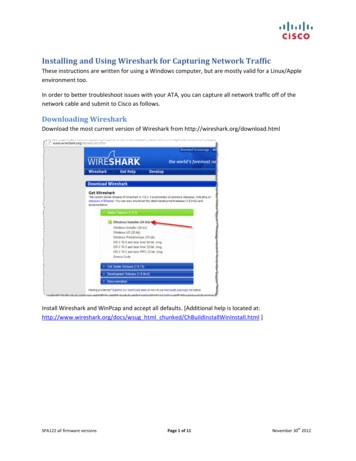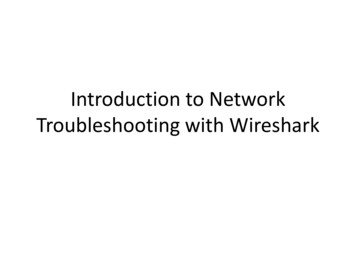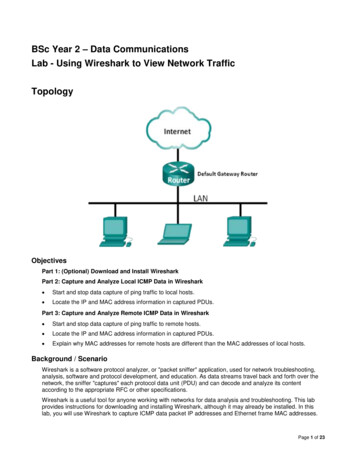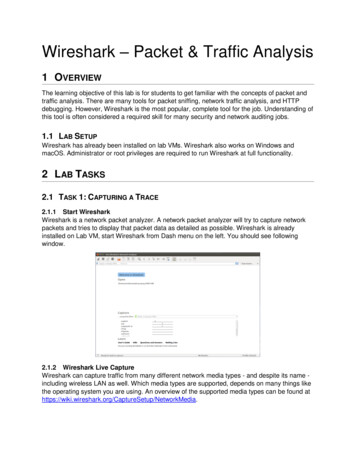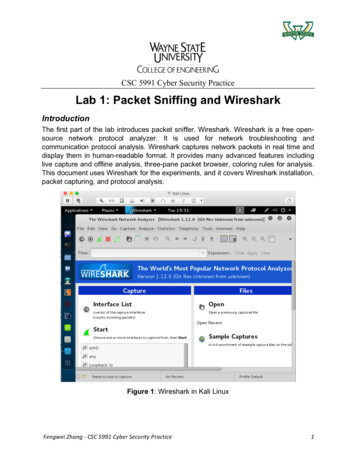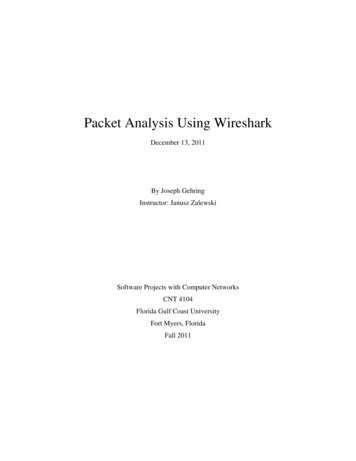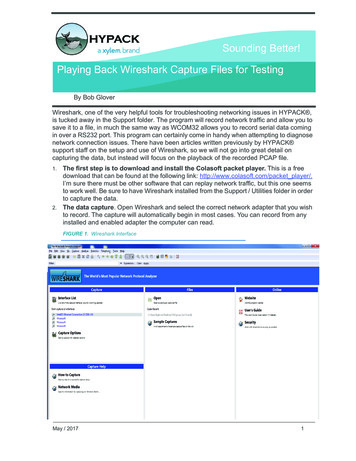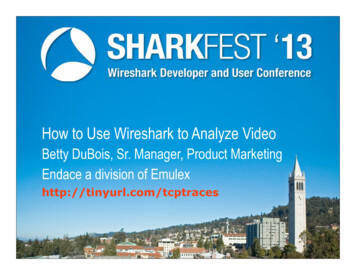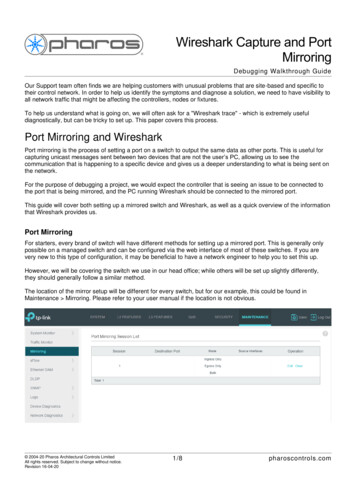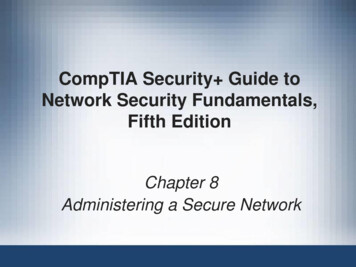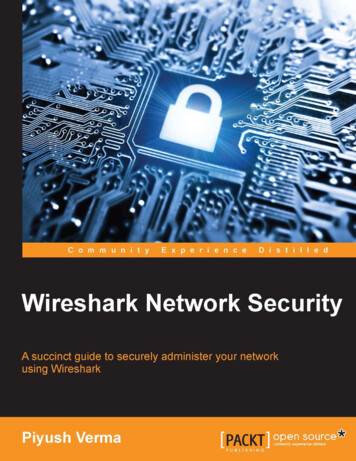
Transcription
Wireshark Network SecurityA succinct guide to securely administer your networkusing WiresharkPiyush VermaBIRMINGHAM - MUMBAI
Wireshark Network SecurityCopyright 2015 Packt PublishingAll rights reserved. No part of this book may be reproduced, stored in a retrievalsystem, or transmitted in any form or by any means, without the prior writtenpermission of the publisher, except in the case of brief quotations embedded incritical articles or reviews.Every effort has been made in the preparation of this book to ensure the accuracyof the information presented. However, the information contained in this book issold without warranty, either express or implied. Neither the author, nor PacktPublishing, and its dealers and distributors will be held liable for any damagescaused or alleged to be caused directly or indirectly by this book.Packt Publishing has endeavored to provide trademark information about all of thecompanies and products mentioned in this book by the appropriate use of capitals.However, Packt Publishing cannot guarantee the accuracy of this information.First published: July 2015Production reference: 1240715Published by Packt Publishing Ltd.Livery Place35 Livery StreetBirmingham B3 2PB, UK.ISBN 978-1-78439-333-5www.packtpub.com
CreditsAuthorPiyush VermaReviewersDavid Guillen FandosProject CoordinatorNidhi JoshiProofreaderSafis EditingMikael KanstrupJaap KeuterTigran MkrtchyanCommissioning EditorAmarabha BanerjeeAcquisition EditorLarissa PintoContent Development EditorSiddhesh SalviTechnical EditorMadhunikita Sunil ChindarkarCopy EditorDipti MankameIndexerPriya SaneProduction CoordinatorShantanu N. ZagadeCover WorkShantanu N. Zagade
About the AuthorPiyush Verma currently serves as a senior security analyst at NII Consulting,India, and enjoys hacking his way into organizations (legally) and fixing thevulnerabilities encountered. He strongly values hands-on experience overcertifications; however, here are a few certifications he has earned so far: OSCP,CEH, CHFI, CCNA Security, and CompTIA Security . He is a highly sought-afterprofessional speaker and has delivered security training to folks working in public,private, and "secret" sectors. He can be contacted at https://in.linkedin.com/in/infosecpiyushverma.
AcknowledgmentG.B. Stern quoted: "Silent gratitude isn't much use to anyone."First and foremost, my deepest gratitude goes to my family, for being the perfect mixof love and chaos. My father, for his guidance and faith in my decisions; my mother,for her unconditional love and the awesome delicacies I much relish; and my sisters,for their love and support.Thanks to these influential personalities in my journey so far: Mr. Dheeraj Katarya,my mentor, for all that you've taught me, which goes beyond the technical lessons;Mr. Sanjay Sharma, who is always a big motivator; Mr. Rahul Kokcha, for makingthe most difficult concepts easy to comprehend; Mr. Santosh Kumar, for his expertinsights on Wireshark; Mr. K.K. Mookhey, for whom nothing is unachievable andhe strives even bigger; Mr. Jaideep Patil, who is lavish in his praise and hearty inhis approbation.It has indeed been a pleasure to work with some of the great minds of the industry.Thanks to Mr. Wasim Halani, who has an answer for everything relevant andis rightly called the "Google" of our organization; Mr. Vikash Tiwary, for whomnothing matches his enthusiasm and the depth of knowledge he possesses. Specialthanks to Saman, Parag, and Avinash for their feedback.I'd also like to thank my friends, who made the most difficult times fun and funtimes the most memorable.Also, this book would have been difficult to achieve without the fantastic editorialteam at Packt Publishing and the prodigious reviewers who helped bring out thebest in me.Ultimately, as the genius Albert Einstein quoted:"I am thankful to all those who said no. It's because of them I did it myself."
About the ReviewersDavid Guillen Fandos is a young Spanish engineer who enjoys being surroundedby computers and anything related to them. He pursued both his degrees, an MSc incomputer science and an MSc in telecommunications, in Barcelona and has workedin the microelectronics industry since then.He enjoys playing around in almost any field, including network security, softwareand hardware reverse engineering, and anything that could be considered security.Despite his age, David enjoys not-so-new technologies and finds himself workingwith compilers and assemblers. In addition to networking, he enjoys creatinghacking tools to exploit various types of attacks.David is now working at ARM after spending almost 2 years at Intel, where he doessome hardware-related work in the field of microprocessors.I'd like to thank those people in my life who continuously challengeme to do new things, do things better than we do, or just change theway we look at life—especially those who believe in what they doand who never surrender no matter how hard it gets.Mikael Kanstrup is a software engineer with a passion for adventure and thethrills in life. In his spare time, he likes kitesurfing, riding motocross, or just beingoutdoors with his family and two kids. Mikael has a BSc degree in computerscience and years of experience in embedded software development and computernetworking. For the past decade, he has been working as a professional softwaredeveloper in the mobile phone industry.
Jaap Keuter has been working as a development engineer in the telecommunicationsindustry for telephony to Carrier Ethernet equipment manufacturers for the past2 decades. He has been a Wireshark user since 2002 and a core developer since 2005.He has worked on various internal and telephony-related features of Wireshark aswell as custom-made protocol dissectors, fixing bugs and writing documentation.Tigran Mkrtchyan studied physics at Yerevan State University, Armenia,and started his IT career as an X25 network administrator in 1995. Since 1998, he hasworked at Deutsches Elektronen-Synchrotron (DESY)—an international scientificlaboratory, located in Hamburg, Germany. In November 2000, he joined the dCacheproject, where he leads the development of the open source distributed storagesystem, which is used around the world to store and process hundreds of petabytesof data produced by the Large Hadron Collider at CERN. Since 2006, Tigran hasbeen involved in IETF, where he takes an active part in NFSv4.1 protocol definition,implementation, and testing. He has contributed to many open source projects,such as the Linux kernel, GlassFish application server, Wireshark network packetanalyzer, ownCloud, and others.DESY is a national research center in Germany that operates particle acceleratorsused to investigate the structure of matter. DESY is a member of the HelmholtzAssociation and operates at sites in Hamburg and Zeuthen.DESY is involved in the International Linear Collider (ILC) project. This projectconsists of a 30-km-long linear accelerator. An international consortium decided tobuild it with the technology developed at DESY. There has been no final decision onwhere to build the accelerator, but Japan is the most likely candidate.
www.PacktPub.comSupport files, eBooks, discount offers, and moreFor support files and downloads related to your book, please visit www.PacktPub.com.Did you know that Packt offers eBook versions of every book published, with PDFand ePub files available? You can upgrade to the eBook version at www.PacktPub.comand as a print book customer, you are entitled to a discount on the eBook copy. Get intouch with us at service@packtpub.com for more details.At www.PacktPub.com, you can also read a collection of free technical articles, signup for a range of free newsletters and receive exclusive discounts and offers on Packtbooks and ion/packtlibDo you need instant solutions to your IT questions? PacktLib is Packt's online digitalbook library. Here, you can search, access, and read Packt's entire library of books.Why subscribe? Fully searchable across every book published by Packt Copy and paste, print, and bookmark content On demand and accessible via a web browserFree access for Packt account holdersIf you have an account with Packt at www.PacktPub.com, you can use this to accessPacktLib today and view 9 entirely free books. Simply use your login credentials forimmediate access.
Table of ContentsPrefaceChapter 1: Getting Started with Wireshark – What, Why,and How?SniffingThe purpose of sniffingPacket analysisThe tools of the tradeWhat is Wireshark?The Wireshark interface – Before starting the captureTitleMenuMain toolbarFilter toolbarCapture frameCapture HelpThe Files menuOnlineThe Status barFirst packet captureSummaryChapter 2: Tweaking WiresharkFiltering our way through WiresharkCapture filtersDisplay filtersThe list of display filtersWireshark profilesCreating a new profilev11224566677913131414151719192122242525[i]
Table of ContentsEssential techniques in WiresharkThe Summary windowThe Protocol Hierarchy windowThe Conversations windowThe Endpoints windowThe Expert Infos windowWireshark command-line mary35353636Starting the captureSaving the capture to a fileUsing filtersStatistics33343434Chapter 3: Analyzing Threats to LAN SecurityAnalyzing clear-text trafficViewing credentials in ng data stream41Case study41Examining sniffing attacksMAC floodingARP poisoningAnalyzing network reconnaissance techniquesExamining network scanning activities4344454646OS fingerprinting attemptsDetect password cracking attemptsBrute-force attacks535454Detect the scanning activity for live machinesIdentify port scanning attemptsOther scanning attemptsIdentifying POP3 password crackingHTTP basic authenticationDictionary-based attacks464852555556Detecting FTP password cracking56Miscellaneous attacksFTP bounce attack5757[ ii ]
Table of ContentsDNS zone transferSSL stripping attackComplementary tools to WiresharkXplicoSysdigPcap2XMLSSHFlowImportant display filtersFilters based on protocolsDNSFTPHTTPFilters based on unique signatures and regular expressionsRegular expressionsNailing the CTF challengeSummaryChapter 4: Probing E-mail CommunicationsE-mail forensics challengesChallenge 1 – Normal login sessionChallenge 2 – Corporate espionageAnalyzing attacks on e-mail communicationsDetecting SMTP enumerationUsing an auxiliary module in MetasploitAnalyzing SMTP relay attackImportant filtersSummaryChapter 5: Inspecting Malware TrafficGearing up WiresharkUpdated columnsUpdated coloring rulesImportant display filtersMalicious traffic analysisCase study – Blackhole exploit kitProtocols in actionThe IP address of the infected boxAny unusual port numberA compromised websiteInfected 576767883848485858687888889899090909192949698IRC botnet(s)InspectionSummary9999102[ iii ]
Table of ContentsChapter 6: Network Performance Analysis103Index113Creating a custom profile for troubleshootingOptimization before analysisTCP-based issuesCase study 1 – Slow InternetAnalysisCase study 2 – Sluggish downloadsAnalysisCase study 3 – Denial of ServiceSYN floodSummary[ iv ]104105106107108108109110111111
PrefaceWireshark is the tool of choice for network administration and troubleshooting,but its scalability goes beyond that. It is an excellent aid in performing an in-depthanalysis of issues pertaining to the overall security of the network. Several toolsand devices are available in the market to detect network-related attacks and takeappropriate actions based on a predefined set of rules. However, at a very granularlevel, it all boils down to frames, or sometimes interchangeably called as packets,and the data they carry.This book is written from the standpoint of using Wireshark to detect securityconcerning flaws in commonly used network protocols and analyze the attacks frompopular tools such as Nmap, Nessus, Ettercap, Metasploit, THC Hydra, and Sqlmap.In the later part of the book, we will dive into inspecting malware traffic from anexploit kit and IRC botnet and solve real-world Capture-The-Flag (CTF) challengesusing Wireshark, basic Python code, and tools that complement Wireshark.What this book coversChapter 1, Getting Started with Wireshark – What, Why, and How?, provides anintroduction to sniffing and packet analysis and its purpose. Later, we will look atwhere Wireshark fits into the picture and how it can be used for packet analysis byperforming our first packet capture.Chapter 2, Tweaking Wireshark, discusses the robust features of Wireshark and howthey can be useful in terms of network security. We will briefly discuss the differentcommand-line utilities that ship with Wireshark.[v]
PrefaceChapter 3, Analyzing Threats to LAN Security, dives into performing sniffing andcapturing user credentials, analyzing network scanning attempts, and identifyingpassword-cracking activities. In this chapter, we will also learn to use importantdisplay filters based on protocols and common attack-tool signatures andalso explore regular expression-based filters. Then we will look at tools thatcomplement Wireshark to perform further analysis and finally nail aninteresting CTF challenge via the techniques learned in the chapter.Chapter 4, Probing E-mail Communications, focuses on analyzing attacks onprotocols used in e-mail communication and solving a couple of real-worlde-mail communication challenges using Wireshark.Chapter 5, Inspecting Malware Traffic, starts with creating a new profile underWireshark for malware analysis and then picks up a capture file from an exploit kitin action and diagnoses it with the help of Wireshark. Later, we also give a brief oninspecting IRC-based botnets.Chapter 6, Network Performance Analysis, begins by creating a troubleshooting profileunder Wireshark and then discusses and analyzes TCP-based issues and takes upc
This book is written from the standpoint of using Wireshark to detect security- concerning flaws in commonly used network protocols and analyze the attacks from Analyzing Threats to LAN Security
